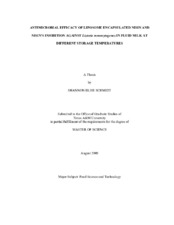| dc.description.abstract | Nisin is a naturally occurring food antimicrobial that inhibits many Grampositive
pathogens, including Listeria monocytogenes, a bacterial pathogen responsible
for ~500 deaths in the U.S. annually. Factors known to counteract the nisin activity in a
food matrix include: antimicrobial interaction with food components, insolubility,
protease inactivation, and target cell-driven envelope modifications. Encapsulating nisin
in liposomes can help protect nisin functionality by regulating its introduction to the
external environment. The objectives of this study were to determine the encapsulation
efficiency (%EE) of nisin within liposomes as a function of encapsulation method and
the capacity of liposomal nisin to inhibit L. monocytogenes in fluid milk.
Phosphatidylcholine (PC) and phosphotidyl-DL-glycerol (PG) were used to
prepare three lipid molar formulations: PC, PC/PG 7:3, and PC/PG 6:4 (mol.%).
Liposomes were formulated to entrap the self-quenching fluorophore calcein and nisin.
Unencapsulated analyte was removed via size-exclusion chromatography, and percent
EE was determined. To determine antilisterial activity of liposomes, fluid milk samples
containing L. monocytogenes (4 log10 CFU/mL) in combination with liposomal or unencapsulated nisin at 50 IU/mL were mixed and aerobically stored at 5 degrees C and 20 degrees C.
Surviving L. monocytogenes were enumerated via plating on a non-selective
microbiological medium after 0, 1, 3, 6, 12, 24, 48, and 72 hours of incubation.
Encapsulation of nisin via extrusion resulted in a mean EE% of 84.20%, 77.33%
and 80.78% for PC, PC/PG 7:3, and PC/PG 6:4 liposomes, respectively. Freeze-thaw
cycling formed liposomes without detectable fluorophore entrapment. L. monocytogenes
populations grew to 5 log10 CFU/mL after 72 hours at 5 degrees C and 8 log10 CFU/mL at 20 degrees C
after 48 hours. Unencapsulated nisin exerted statistically greater inhibition of Listeria in
skim milk compared to liposomal nisin, regardless of incubation temperature. No
statistically significant differences in Listeria populations exposed to free or
encapsulated nisin in whole milk were observed at either incubation temperature. Results
indicate storage temperature and presence of milk fat exert greater influence then nisin
delivery (free vs. encapsulated) over Listeria inhibition. Further research is needed to
confirm these findings and develop more effective means of liposome entrapment of
nisin for the inhibition of foodborne bacterial pathogens. | en |


